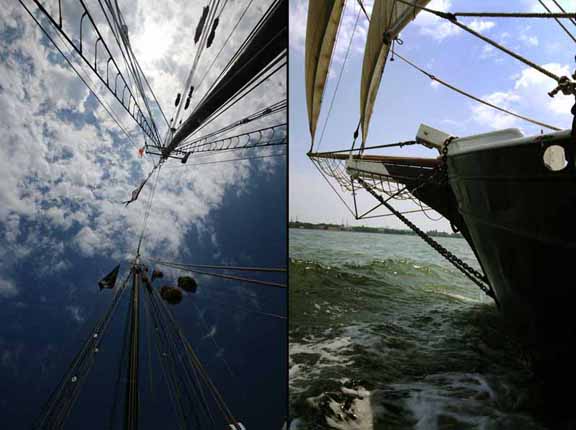Avoiding Camera Damage, Water, Humidity, Dust, Vibrations and Heat

Digital Photo Academy and LivinginHD present a free monthly series of photography webinars on LivinginHD.com. Your host, John Bentham answers many questions live during the webinars. Additional questions, answers and tips are posted here on digitalphotoacademy.com where you can also view the archived webinars.
There are a few basic rules to follow when using cameras in adverse environments. Camera Rain Covers, Waterproof Housings, or even Plastic Bags will prevent your camera from being damaged or the loss of your precious vacation photos.

Photo by John Bentham, DPA Instructor New York
The photos above were shot during a Special Advanced DPA Sailing workshop in NY Harbor. Booming the camera over the water with a Monopod enabled John to get an interesting angle and perspective of the historic sailboat. The camera was precariously close to the choppy water and spray and a camera rain cover was used to cut down the risk. In the event of immersion the camera would have been damaged, to avoid this a waterproof camera housing might have been safer but it all worked out in the end.
If your camera gets wet follow this advice:
If your camera gets wet Turn it OFF and remove the battery.
If camera is OFF, Don’t turn it ON to see if it still works. Do remove the battery.
If the exposure to water is minor (camera was sprayed or lightly splashed). Remove the battery. Wipe dry and set camera and battery in front of a fan for 3-4 days until it dries out. If the exposure to water is Major, (heavy splash or submerged). Remove the battery. Wipe both camera and battery dry and take in for repair BEFORE it dries out.

Humidity in tropical and hot locations (Caribbean, India, Asia, Central & South America etc): This is a real problem. Humidity will affect cameras, lenses, film, everything. If you’re hotel room, airplane or car is air-conditioned and then you take the cameras outside you will have a lot of condensation on the lenses, viewfinder, film etc. This is because the camera is colder than the outside air and the moisture in the air condenses on the cold surface. If you wipe it off it will just form again. You can’t really do anything until the camera and lens have warmed to the ambient temp outside. This takes about 20 minutes. Make sure you warm the equipment before you need to shoot. It helps if you don’t keep your AC really cold. You also risk the more serious problem of moisture inside the lens, between the elements. This will happen after prolonged exposure to humidity and you risk fungus growing inside the lens. This is difficult and costly to remove (you need to take the lens apart). You should keep the equipment in Zip lock bags with moisture absorbing paks (silica gel). Additionally after I return from the tropics I seal all the equipment in a plastic bin (like a large Tupperware container) with numerous packets of silica for a week or so to and dry out any residual moisture.
Splashes, Rain, Moisture, Dust, Sand: Watch out for sudden rainstorms in the tropics. It can be a beautiful sunny day and suddenly start to pour torrential rain. A small collapsible umbrella in the camera bag is a great idea, also carry a large plastic bags to shove the whole camera bag into. These are also good for keeping out sand on the beach or in desert environments. It’s amazing how sand can work it’s way into all the compartments in a camera bag. After a shoot in the desert in Morocco I found sand inside a Zip-lock bag that was inside a camera bag, the sand was blowing and had worked it’s way in there. Be very careful with the sensor on a digital camera with regard to sand and dust. It is best to keep a lens on a camera body rather than changing it in the field if at all possible. This is another reason to carry a 2nd camera body – so you can keep two focal lenses on two bodies and not risk dust settling on the sensor while in a dusty environment.
Waterproof Cameras: Your best bet to avoid any water, humidity and dust damage is going with a waterproof camera. Many waterproof models are available or alternatively you can buy a waterproof housing for an existing camera. Panasonic makes two models which are waterproof, shockproof and freezeproof, the TS2 and TS10. These are also great cameras to allow the kids to play with as they are virtually indestructible. You can take them to the beach or in the pool without any worries.

Airplane Vibrations and Heat: Cameras are subject to high frequency vibration from airline engines. A camera repair technician told me they see this all the time. The vibrations loosen all the screws etc. Cameras should never be placed loose on the floor of an airplane and there should be lots of padding in the bottom of the case if it goes under the seat. I add a layer of high-density foam (extra computer mouse pads) to the bottom of my camera bags for this reason. I once boarded a small island hopper twin prop plane that had virtually NO no carry-on baggage space. I stopped the baggage handlers as they were about to put my camera bag in a stowage space located in the wing directly above the engine. The cameras would have been shaken apart. I hung the cameras around my neck to avoid any problems. If you are ever on a small island hopper flight that is full and has too much luggage make sure yours is not the bag left behind. They will sometimes do this and ship the excess baggage on the next flight. It’s better to grease the guy $20 than to risk never seeing your equipment again. I had to do this in the Australian outback.



